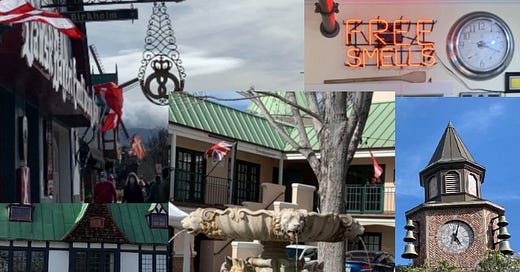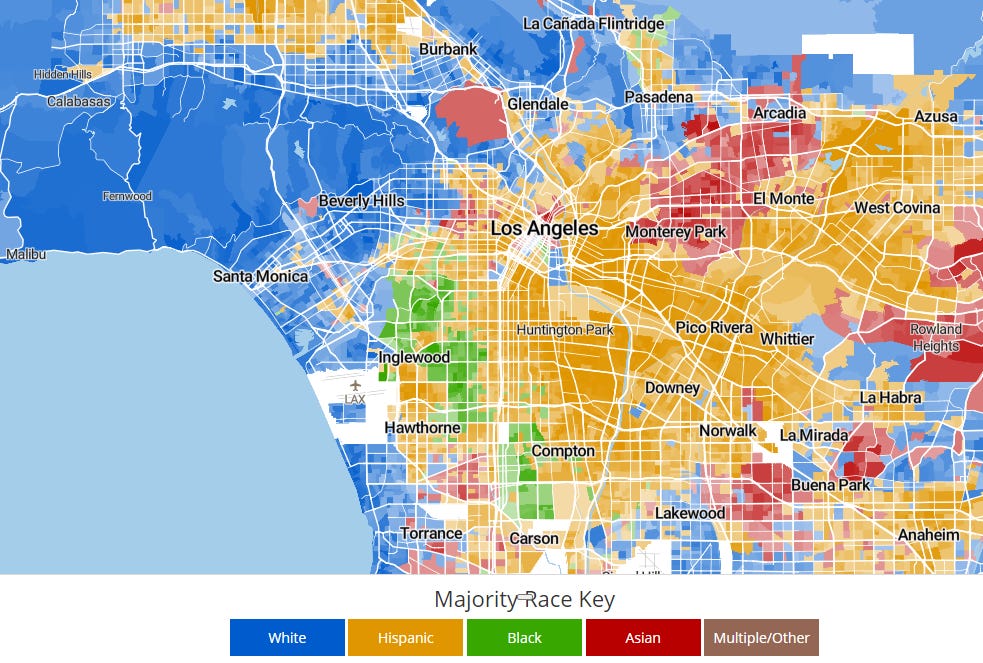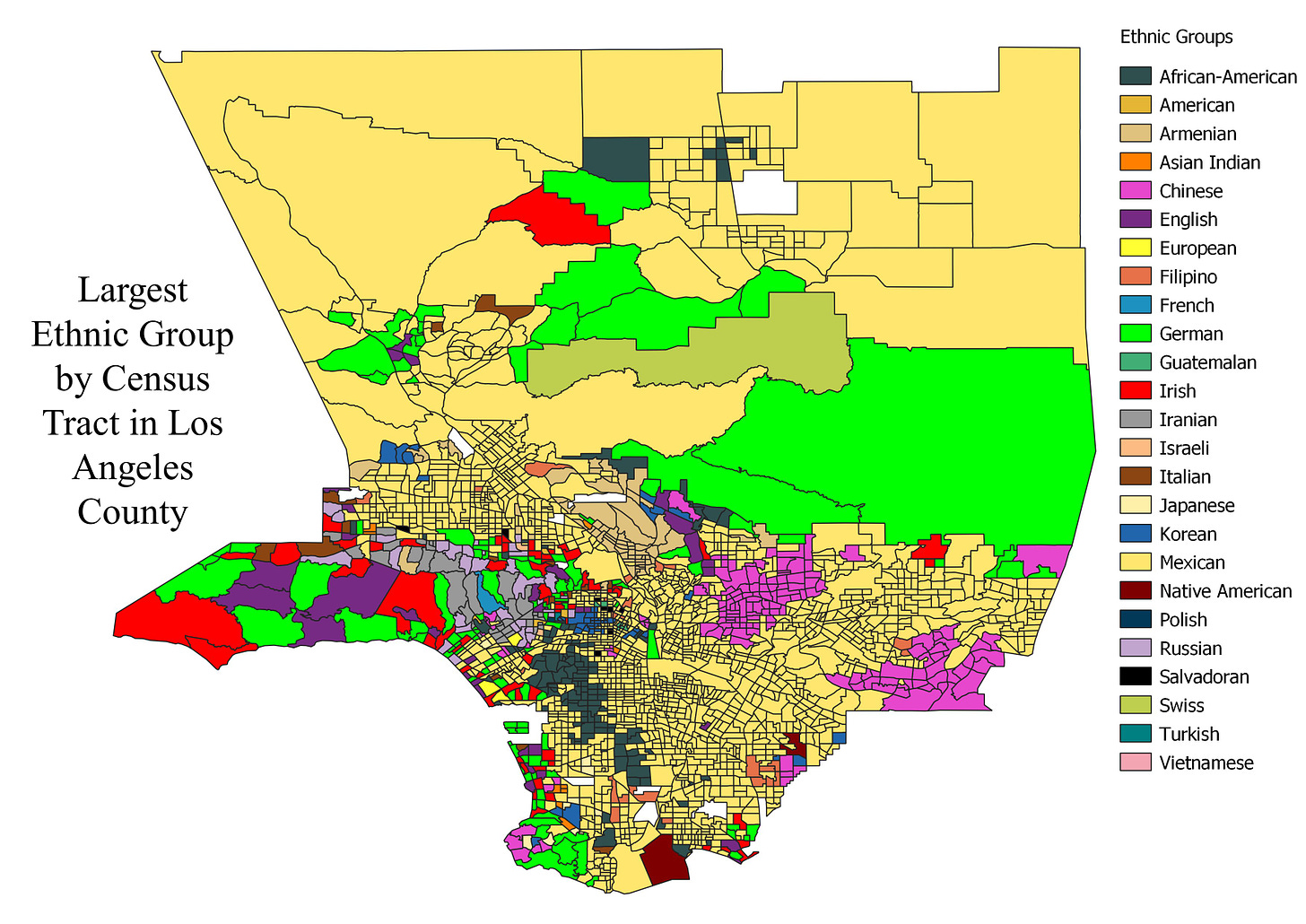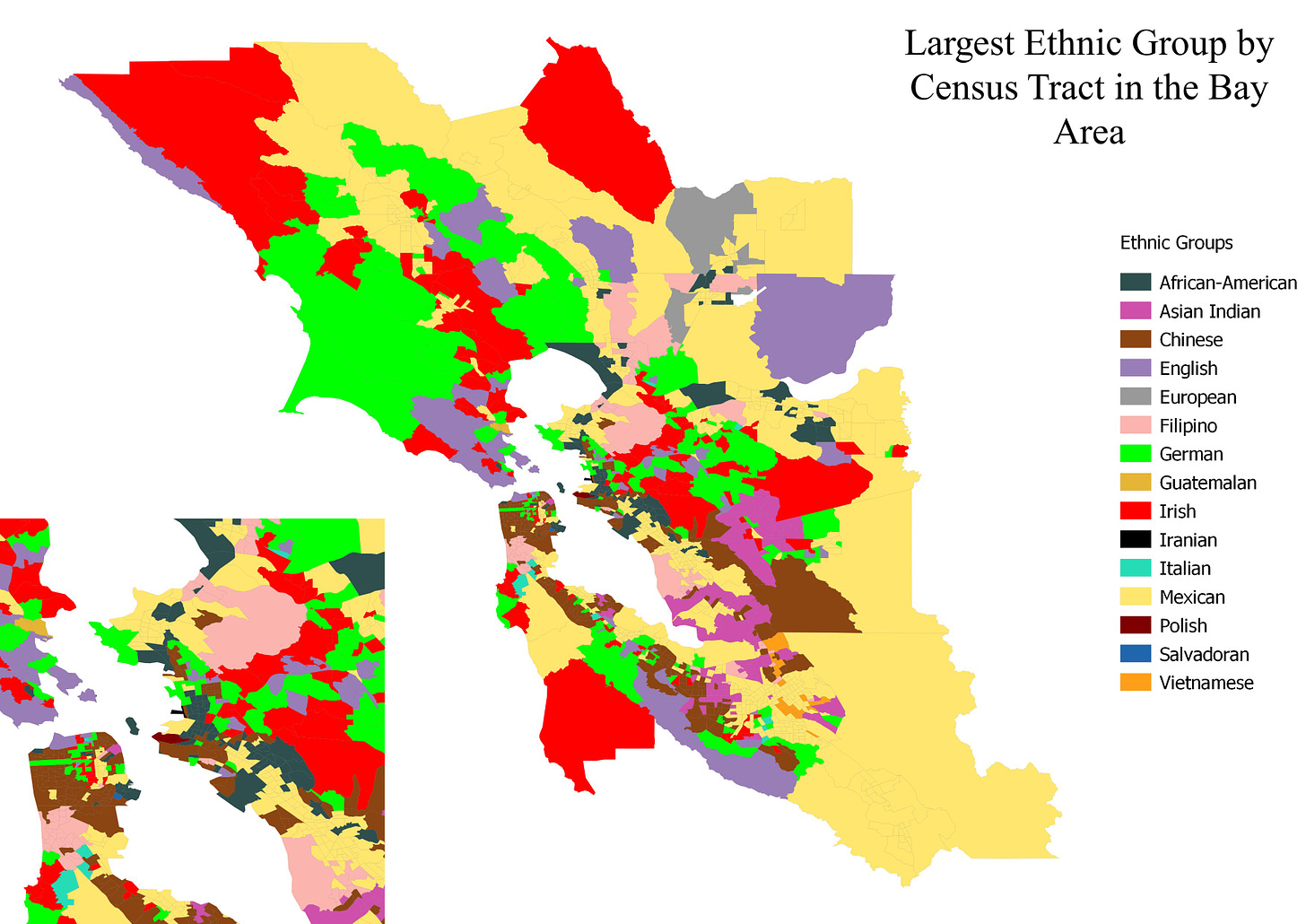California prides itself on its diversity with race relations that are generally better than many other parts of the nation. However, California, as a beacon for diversity, does have major problems including income inequality and a massive exodus out of the state. Problems with the housing shortage and out-of-touch centralized institutions create a zero sum competition that could lead to greater social problems, political tension, and worse race relations down the road.
For instance the housing crisis has been linked to the broader woke culture war with a focus on single family zoning being linked to increasing segregation. Besides the problem of displacement in housing there is a greater trend of fragmentation with emerging enclavism throughout California. This trend of ethnic fragmentation is especially strong in the urban areas of Los Angeles and the San Francisco Bay Area with a new interactive segregation map for the Bay Area showing which areas are the most segregated.
Urbanist Richard Florida at Bloomberg’s Citylab documents how there has been greater demographic fragmentation in urban areas based upon research from a study by Elizabeth Delmelle: a professor of geography and earth sciences at the University of North Carolina, Charlotte. The study tracks demographic changes from 1990 to 2010 with a wide range of categories based upon socio-economic status and ethnicity.
These demographic trends are neither the strict segregation of the past nor the blended society that was the dream of liberalism but, rather, a quilt-like patchwork of many different enclaves. The LA Times has a diversity index for Los Angeles neighborhoods and, as with the Bay Area’s segregation map, we can see that the most diverse areas are, generally, either middle-income areas with a high concentration of new apartment construction or areas that are undergoing a transformation such as gentrification, or attracting a new demographic.
The YIMBYs are correct that allowing new housing construction increases diversity but these areas also tend to be more transient with less social capital. The only communities in these urban metros that have a decent amount of social capital tend to be either close-knit ethnic enclaves or affluent family-oriented communities.
Looking over these color-coded demographic maps of the Los Angeles Metro and San Francisco Bay Area further demonstrates the trend of geographic consolidation into demographic blocks or enclaves. The truly diverse areas are outliers and tend to be located on the edge of more homogenous blocks or in the process of being absorbed into a solid block. These demographic maps of Los Angeles and the Bay Area portray an image that is closer to a mosaic or an assortment of de-facto micro-nations rather than the liberal ideal of the melting pot, which is generally the case in multi-ethnic nations.
Source: Best Neighborhood
Source: Siddharth Khurana on Twitter
Source: Best Neighborhood
Source: Siddharth Khurana on Twitter
In response to greater demographic fragmentation, the woke left has pushed for policies geared towards racial equity such as a UC Berkeley study offering solutions to diversify Bay Area neighborhoods. The only counter position is from conservatives, who are marginal in California, with calls for assimilation like the English Only Movement. Both the equity agenda of woke liberalism and conservative’s assimilationist model would not work in a place as immensely diverse as California. Both sides are stuck in the past (the logic of the 60s Civil Rights Movement for liberals or a desire to return to the America of an earlier point, for conservatives) and offer a false paradigm that resists the inevitable trend of enclavism as part and parcel of a multi-cultural and multi-ethnic future.
Within the context of California, the issues is not so much racial conflict but rather the transient nature of people constantly relocating, the scarcity of social capital, and an overall hyper competitive social and economic environment. Diversity is one of California’s strengths but also poses potential hurtles for social cohesion under the existing arrangement, as institutions struggle to meet the unique needs of distinct groups.
In order to adapt to this inevitable future we must embrace a pluralist vision for California that is best suited for a state as diverse as California, including specialized plans to better address the unique needs of the diverse demographics. There is also potential for enclaves to provide better services, social capital, and a higher quality of life than what can be provided by mass society and centralized institutions.
California is a multicultural patchwork with countless examples of existing enclaves such as Chinatowns, Tehrangeles and Koreatown in Los Angeles, as well as the many Chicano and Mexican neighborhoods. Beyond existing designated enclaves, there are broader de-facto pan-enclaves with examples including Asian American areas in the San Gabriel Valley and parts of Northern Orange County, both South and East Asian areas throughout the Silicon Valley, African American areas in Historic South LA and parts of Oakland and Richmond in the Bay Area, and the heavily Jewish parts of LA’s Westside and San Fernando Valley.
You could even make the case that many European American areas in California are beginning to function as enclaves. Examples include the Sacramento Suburbs in Placer County, Clovis in the Fresno metro, parts of Marin County and Central Contra Costa County in the San Francisco Bay Area, San Luis Obispo on the Central Coast, South Eastern Ventura County, South Orange County, and North San Diego County.
In an East Bay Times article about a diversity summit to address racism at an affluent East Bay suburban school district it mentions that the school district Acalanes Union High School District “is a predominantly white, affluent suburban district in Contra Costa County. Of the students who “enrolled in 2017-18, 64.9 percent were white, 13.7 percent were Asian, 9.9 were percent Hispanic or Latino, and 1.7 percent were African-American.”
There is an implication that Whiteness is racism or at the very least exclusionary of others with the article deliberately uncapping the term White. To give a demographic comparison, California public school enrollment is only 22.9% White compared with 47% for the United States. The recent massive decline in enrollment, especially White enrollment, in San Francisco schools is proof that these woke policies fail at their objective of integration.
This broader push to “diversify” White areas is based upon the dishonest premise of the majoritarian framework of American History which does not reflect California’s diversity and the reality that no ethnic group forms a majority. In a minoritarian pluralist sense, however, the concept of a Whitetopia--a term used to describe White flight zones—is analogous to an ethnic enclave or ethnoburb, just like an immigrant community.
This is the reality that we are beginning to see in California, but the greater push for integration in education in California and other woke proposals to engineer demographic change does tremendous harm to the objective of true diversity in a pluralist society. Many of these White enclaves are both liberal within the current framework but also very restrictive in terms of accommodating new residents from different backgrounds. Enclavism could ease the prejudices against zoning reform and lead to more dynamic communities.
Areas designated enclaves could be granted a degree of autonomy such as greater control over institutions including education, and as with specialized plans for different ethnic groups, it can better address the needs of particular communities. This is a case that must be made against detractors who claim the model is discriminatory.
There has been displacement of longstanding businesses in ethnic enclaves such as San Francisco’s Chinatown, for instance, and ideally local businesses that serve the community would be given greater support and priority over corporate chains. While pan-enclavism is controversial, it addresses many other concerns of the left. For instance, concerns about lower income minority residents being displaced by gentrification. In this model residents could be given priority in housing.
As for the left’s concern about policing in inner-city communities, enclaves could have a greater say about policing issues. African American areas, for instance, that have troubled relations with the police would be granted a greater say about local policing which makes more sense than electing woke DA’s such as Gascon in LA who impose a disastrous one size fits all approach upon the whole population.
Education is another example of centralized institutions that don’t adequately serve their communities. For instance Orthodox Jews who have large families pay a tremendous cost on private education and are not served by the schools in their enclaves that are currently part of public education in cities such as LA. This pluralist model could coincide with overall education reform including breaking up failed large urban school districts and state subsidies for homeschooling and private education.
This model could also coincide with urbanist reform with community centers throughout neighborhoods and a positive vision created by artists from communities, designing and reviving enclaves, and planning cultural and social events, to foster social cohesion. The urbanist and aesthetic component of pan-enclavism could have an effect similar to the theme park model exemplified by Disney parks: imagine being able to travel the world within one region or state.
Ironically this kind of enjoyable diversity is the dream of aspiring, well-off liberals who desire the luxury of safely enjoying many cultures, but the modern left’s version of multi-culturalism has failed to live up to this dream. It went from the selling point of enriching one’s life via exposure to a wide variety of cultures, to feeling guilt for one’s own culture and ethnic background. There are social benefits to both diversity and more homogenous societies and with pan-enclavism, people can have their cake and eat it too.
There is a history of enclaves being created as safe havens from discrimination and oppression, however people end up staying and investing in these communities because of what they can provide that is not by society at large. In most case these enclaves were created by private citizens such as the many urban immigrant communities with other examples including Freedom, Georgia, a community recently created as a safe haven for African Americans in light of police brutality, the Afrikaner settlements of Kleinfontein and Orania in South Africa, religious communities such as the Mennonites of Belize, Mormon communities in the Interior American West and the Yiddish speaking Hassidic enclave of Kiryas Joel in New York. However, one example of state sponsored enclaves is the autonomy granted to Native Americans. Even if flawed due to the history of oppression and neglect by the US Government, the citizens of Native American reservations are granted some degree of autonomy, their own institutions, and a birthright for their descendants that most of society does not have access to.
A hypothetical vision for Pan-enclavism could include granting more rights to existing ethnic enclaves or creating a patchwork of semi-autonomous regions throughout the State but the top down implementation of enclavism by the state is totally impractical and is not what I’m proposing. What this pluralist vision does call for is more local based control and local based institutions and policies geared towards economic and political decentralization that could give people the tools to formant enclavism organically. The economic theory of Distributism is the most compatible with this vision as well as policies such as the Left-Libertarianism position of direct social payments without bureaucratic control fused with the Rightest/Paleolibertarian support for greater Freedom of Association that is limited under the current order.
This pluralist vision draws inspiration from many models, both that have been implemented and merely proposed, including the boroughs concept from the New York Mayoral campaign of 60s counter-culture icon Norman Mailer, which offered out of the box solutions to reconcile differences between various groups at odds with each another, such as inner city African Americans concerned about police oppression, and White New Yorker’s complaints about school busing at the height of late 60s Civil Unrest. Mailer’s platform on education stated “The neighborhoods would have complete control over their school systems, including which teachers to hire, what curricula to teach, and what grading and testing methods would be used” and on crime: that “Local neighborhoods would know best how to control crime in their communities by employing policemen who have the respect of the community because they live there.”
These types of policies are what is needed to address the problems of today in such a fragmented society. Other inspirations come from Ethnopluralism associated with the European New Right, Neo-Reactionary Mencius Moldbug's vision for a patchwork of autonomous micro regions, the autonomy of the Swiss Canton model, the Dutch and Belgium political system of Pillarization, the political concept of Parallelism, the original vision of Canadian Multi-Culturalism that rejected America’s melting pot in favor of a mosaic (even if today’s Canada epitomizes woke neoliberalism) and the policies and vision of Singapore’s Lee Kuan Yew who created a functioning multi-cultural society using out-of-the box solutions.
As for barriers to pluralism and pan-enclavism, the most likely opposition would be from those who are economically and politically invested in institutional power and maintaining mass society as well as an ideological strain of liberalism which values the sanctity of institutions with a belief that strong centralized institutions are necessary to maintain equity and uphold liberal principles including civil rights. Even the Black Civil Rights movement had this divide with Marcus Garvey calling for Black Economic Empowerment via alternative institutions in contrast with the establishment approved vision of Martin Luther King with an objective of equal representation of diversity within mass society and the dominant institutions.
This is the basis of the current political paradigm that is very much opposed to any kind of peaceful diversity or enclavism that doesn’t involve Whites bearing the brunt of the costs. The current paradigm is based upon top-down institutional power which is an issue that goes beyond the demographic breakdown of society. In California, opposition to pluralism would likely come from the Democratic Party, and other bureaucracies, and corporations including Big Tech.
As far as how the populace would respond: the Left is too attached to the narrative that Whites need to give up power for the purpose of equity and consider the concept of local control to be racist, Right-wingers hate the idea of diversity, even if pan-enclavism is less actively detrimental to Whites, and center-right and center-left types, especially the older generations, will simply never let go of the Universalist American liberal ideal and the idea of one unified society. All of these outlooks have failed but any serious change will require a cataclysmic event to pave the way for multi-culturalism for all.
Regardless, the existing framework, despite its institutional power, is creating a backlash against woke culture and ironically leading to neo-tribalism by pursuing woke segregationist polices that move us away from unity. This coincides with a system that is failing to meet many people’s social and economic needs and the problem of elite overproduction, as the push to diversify the elites is further exacerbating competition over the limited number of elite spots. The trends of the near future will be further demographic fragmentation, neo-tribalism, a breakdown in institutional trust, people with means insulating themselves from failed institutions, a fragmentation of the elite, and an increased interest in parallel and alternative institutions.
Despite the barriers, a coalition of support for this new pluralist vision could come from younger people who are less invested in the idea of American liberal ideals as Universal, and whose concerns are not being met under mass society and it’s failed institutions. This could include not just the disaffected but also younger Whites in California from the many affluent suburban areas in California that voted for Biden but against affirmative action, who are impacted by elite over production and the insane cost of living in the areas they grew up in.
Other potential support in California could come from many younger minorities, including those who are already practicing enclavism and recent immigrants from neo-tribal/pluralist parts of the world who have yet to be ingrained in the existing paradigm, immigrant communities that the Democratic party is losing support among including Iranians and Vietnamese, and those who are striving to be petite bourgeoise but are under the boot of the managerial elite (eg: the Double Horseshoe Theory of Class politics and the impact of covid on immigrant owned small businesses with business closures benefiting Amazon).
The outdated neoliberal version of multiculturalism has failed but this kind of thinking may inevitably be decades ahead of its time. The case for this pluralist arrangement can be made on the grounds of better meeting the specific needs of individuals and communities, embracing diversity in a true sense, and that true freedom can only come from being able to live in the type of community that one desires and that fulfills one’s needs.







This is how it already works in NYC. You west coasters are late to the game.
Why do you think a balanced ticket here is a white Protestant, a black Protestant, a Catholic and a Jew? And that was in 1950.